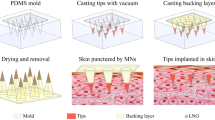Abstract
Purpose. The purpose of this study was to investigate the effects of formulation factors including varying wax concentration, drug loading and drug particle size, on drug release characteristics from both pure oil and gel formulations prepared with a combination of derivatized vegetable oil (Labrafil 1944 CS) and glyceryl palmitostearate (Precirol ATO 5), using levonorgestrel as a model drug.
Methods. The effects of varying drug loadings, different drug particle sizes, and wax (Precirol) concentrations on in-vitro drug release rates were evaluated, and the mechanisms of drug release from the gels were determined.
Results. Zero-order drug release rates from the 10% Precirol gel formulations containing 0.25, 0.50 and 2.00% w/v drug loadings were lower than those observed for oil formulations containing identical drug loadings. Higher zero-order release rates were observed from formulations containing smaller drug particles suspended in both oil and gel formulations. The mechanism of drug release from gels containing less than 0.25% w/w drug was diffusion-controlled. Increasing the wax concentrations in the gels from 5% w/w to 20% w/w significantly decreased the diffusivity of the drug through the gel formulations and markedly increased the force required to inject the gels from two different sizes of needles.
Conclusions. This study shows how modification of the physicochemical properties of the gel formulations by changing the drug particle size, wax concentration and drug loading, affects drug release characteristics from the system.
Similar content being viewed by others
REFERENCES
K. Suzuki and J. C. Price. Microencapsulation and dissolution properties of a neuroleptic in a biodegradable polymer, poly(d,l-lactide). J. Pharm. Sci. 74:21–24 (1985).
R. K. Chang, J. C. Price and C. W. Whitworth. Control of drug release rates through the use of mixtures of polycaprolactone and cellulose propionate polymers. Pharm. Tech. 10:24–33 (1986).
M. Tsakala, J. Gillard, M. Roland, F. Chabot, and M. Vert. Pyrimethamine sustained release systems based on bioresorbable polyesters for chemoprophylaxis of rodent malaria. J. Controlled Rel. 5:233–242 (1988).
Y. Cha and C. G. Pitt. A one-week subdermal delivery system for L-methadone based on biodegradable microcapsules. J. Controlled Rel. 7: 69–78 (1988).
J. P. Benoit, F. Chabot, and M. Veillard. Biodegradable cisplatin microspheres prepared by the solvent evaporation method: Morphology and release characteristics. J. Controlled Rel. 7:217–229 (1988).
N. Leelarasamee, S. A. Howard, C. J. Malanga, and J. K. Ma. A method for the preparation of polylactic acid microcapsules of controlled particle size and drug loading. J. Microencapsulation. 5:147–157 (1988).
Y. Cha and C. G. Pitt. The acceleration of degradation—controlled drug delivery from polyester microspheres. J. Controlled Rel. 8:259–265 (1989).
F. Koosha, R. H. Muller, S. S. Davis, and M. C. Davies. The surface chemical structure of poly(β-hydroxybutyrate) microparticles produced by solvent evaporation process. J. Controlled Rel. 9:149–157 (1989).
J. M. Ruiz, J. P. Busnel, and J. P. Benoit. Influence of average molecular weights of poly(DL-Lactic Acid-Co-Glycolic Acid) copolymers 50/50 on phase separation and in-vitro drug release from microspheres. Pharm. Res. 7:928–934 (1990).
C. G. Pitt. The Controlled Parenteral Delivery of Polypeptides and Proteins. Int. J. Pharm. (Netherlands) 59(3):173–196 (1990).
K. A. Fults and T. P. Johnston. Sustained-release of urease from a poloxamer gel matrix. J. Parent. Sci. Tech. 44(2):58–65 (1990).
J. L. Zatz, J. P. Berry and D. A. Alderman. Gels. In H. A. Lieberman, M. M. Rieger and G. S. Banker (eds.), Pharamceutical Dosage Forms: Dispersed Systems, Marcel Dekker, New York, 1988, Vol. 2, pp. 495–510.
F. H. Buckwalter. Repository penicillin composition. U.S. Patent #2, 507, 193 (1950).
A. L. Thakkar and R. G. Harrison. Injectable semi-solid formulations, European Patent Application, 86306282.4, (1986).
T. A. Barber. Particle Population Analysis. In Pharmaceutical Particulate Matter, Interpharm Press, Buffalo Grove, Illinois, 1993, pp. 271.
W. Higuchi. Analysis of data on the medicament release from ointments. J. Pharm. Sci. 51(8):802–804 (1962).
P. C. Chen-Chow, S. G. Frank. Studies of multiple emulsions as parenteral prolonged release drug delivery systems. Int. J. Pharm. 8:89–99 (1981).
S. C. Chi and H. W. Jun. Release rates of ketoprofen from poloxamer gels in a membraneless diffusion cell. J. Pharm. Sci. 80(3):280–283 (1991).
J. C. Gilbert, J. Hadgraft, A. Bye and L. G. Brookes. Drug release from Pluronic F—127 gels. Int. J. Pharm. 32:223–228 (1986).
F. Bottari, G. Di Colo, E. Nanipieri, M. F. Saettone and M. F. Serafini. Influence of drug concentration on in vitro release of salicylic acid from ointment bases. J. Pharm. Sci. 63(11):1779–1783 (1974).
Author information
Authors and Affiliations
Rights and permissions
About this article
Cite this article
Gao, ZH., Shukla, A.J., Johnson, J.R. et al. Controlled Release of a Contraceptive Steroid from Biodegradable and Injectable Gel Formulations: In Vitro Evaluation. Pharm Res 12, 857–863 (1995). https://doi.org/10.1023/A:1016209020160
Issue Date:
DOI: https://doi.org/10.1023/A:1016209020160




